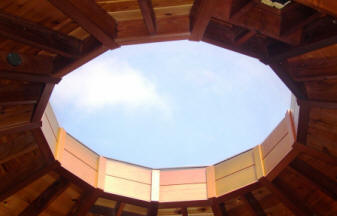skylight shape

Skylights are available in a variety of shapes and sizes. The most common shapes include rectangular, circular, oval, diamond, triangular, multi-sided, and tubular.
Non-rectangular units usually use plastic glazing, but higher quality ones use glass. The glazing can be flat, arched, domed, pyramidal, or "warped plane" – flat on the low side and concave in section on the high side. Of these, the pyramidal, arched, and domed shapes offer flexibility for positioning. Their raised design allows light to enter from more extreme angles than flat or warped plane units. This allows more positioning options.
The slope or curvature of the glazing also helps to shed moisture and leaves. These skylight designs also do not require the additional framing needed to slope a flat skylight for proper drainage on flat or low-slope roofs.
Tubular skylights are smaller than most other skylights. They consist of roof-mounted light or solar collectors, which increase their daylighting potential without the need to increase their size. Because the rooftop solar collector has a small surface area, tubular skylights minimize heat loss in the winter and heat gain in summer. Their small size also minimizes their impact on a home's architecture.
